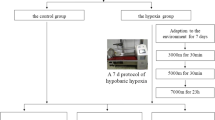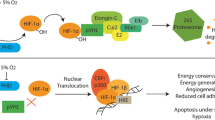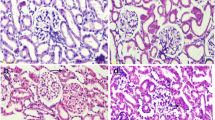Abstract
In order to maintain normal cellular function, mammalian tissue oxygen concentrations must be tightly regulated within a narrow physiological range. The hormone erythropoietin (EPO) is essential for maintenance of tissue oxygen supply by stimulating red blood cell production and promoting their survival. In this study we compared the effects of 290 Torr atmospheric pressure on the kidney EPO protein levels in young (4-month-old) and aged (24-month-old) C57BL/6 mice. The mice were sacrificed after being anesthetized, and kidney samples were collected and processed by Western blot analysis. Relatively low basal expression of EPO during normoxia in young mice showed significant upregulation in hypoxia and stayed upregulated throughout the hypoxic period (threefold compared to normoxic control), showing a slight decline toward the third week. Whereas, a relatively higher normoxic basal EPO protein level in aged mice did not show significant increase until seventh day of hypoxia, but showed significant upregulation in prolonged hypoxia. Hence, we confirmed that there is a progressively increased accumulation of EPO during chronic hypoxia in young and aged mouse kidney, and the EPO upregulation during hypoxia showed a similarity with the pattern of increase in hematocrit, which we have reported previously.
Access provided by Autonomous University of Puebla. Download conference paper PDF
Similar content being viewed by others
Keywords
1 Introduction
In order to maintain normal cellular function, mammalian tissue oxygen concentrations must be tightly regulated within a narrow physiological range [1–5]. One of the adaptive physiological changes in response to chronic hypoxia is polycythemia (increase in hematocrit or packed red blood cell (RBC) volume) [5]. The hypoxic milieu is sensed by the kidney peritubular capillary endothelial cells which increase expression of hypoxia inducible factor-1α (HIF-1α) to enhance erythropoietin (EPO) production [6–8]. The hormone EPO is essential for maintenance of tissue oxygen homeostasis by stimulating RBCs production and promoting their survival [7, 8].
Kidneys are the major sites of EPO production in adults. EPO-expressing cells in the kidney have been identified as interstitial cells in the peritubular space in the cortex and medulla [6]. The liver produces EPO essentially in fetal life and has the potential to produce EPO and actually hepatocytes secrete a small quantity of EPO in adult life [4]. There is also paracrine EPO production in brain [2, 9] and in reproductive organs such as the uterus and testes [10].
There are reports from mice, rats, rabbits, and human studies indicating attenuated induction of HIF-1α in response to hypoxia which may result in reduction of expression of the genes with hypoxia response elements (such as EPO) in old age [11, 12]. It is also shown that many of the HIF-1α-regulated gene protein levels are also upregulated in aged rats and mouse, brain and skeletal muscles, during hypoxia by HIF-1α-independent mechanisms [11, 13]. In this study we also report upregulated EPO expression in the kidneys of aged mice during normoxia and hypoxia.
2 Methods
2.1 Exposure to Chronic Hypobaric Hypoxia
Male C57BL6 mice were purchased from the National Institute for Aging (NIA) and maintained at the Case Western Reserve University Animal Care Facility for a few days before the experiment. Animal housing and handling met Institutional Animal Care and Use Committee standards. Mice that were exposed to hypoxia were placed in hypobaric chambers for a period up to 3 weeks, at a constant pressure of 0.4 ATM (290 Torr, equivalent to 8 % normobaric oxygen). The littermate normoxic control mice were housed in the same room next to the hypobaric chamber to ensure identical ambient conditions.
2.2 Tissue Collection and Preparation of Whole Cell Lysates
Mice were weighed, anesthetized, and sacrificed. Blood samples were obtained for hematocrit determination. Kidneys were dissected and immediately frozen in liquid nitrogen and stored at −80 °C until further processing. Frozen kidney samples were dissected and homogenized in ice-cold lysis buffer (150 mM NaCl, 50 mM Tris–HCl pH 7.4, 1 mM EDTA, 1% Triton X-100, 0.5% sodium deoxycholate, 0.1% SDS, in ddH2O) containing EDTA-free protease inhibitor tablet (Complete Mini, Roche Diagnostics, Indianapolis, IN). Homogenates were kept on ice for an hour and then centrifuged at 14,000 × g for 30 min at 4 °C. Protein contents in the supernatants were determined by a Bradford protein assay (Bio-Rad, Hercules, CA) with bovine serum albumin (BSA) as a standard.
2.3 Western Blot Analysis
Proteins from the whole cell lysates were denatured in Laemmli loading buffer, separated by using SDS gel electrophoresis and transferred to nitrocellulose membranes (Bio-Rad) by standard procedures. The membranes were incubated in 5 % skimmed milk in tris-buffered saline with 0.1 % Tween (TBS-T) for 1 h to block nonspecific binding. Then, the membranes were incubated overnight in the same blocking solution with the primary antibodies. The specific primary antibodies of interest were: EPO (1:500; Santa Cruz Biotechnology, Santa Cruz, CA) and β-actin (1:1,000; Santa Cruz, CA). The membranes were washed three times each for 15 min with TBS-T, followed by incubation with the appropriate horseradish peroxidase-conjugated secondary antibodies (Invitrogen, Camarillo, CA). After a series of three washes each for 15 min with TBS-T, immunoreactive protein bands were visualized using an enhanced chemiluminescence detection system (SuperSignal ECL Kit, Thermo Scientific, IL) and subsequent exposure of the membrane to Hyperfilm (Thermo Scientific, IL). Computer-aided Sigma Scan was used to quantify densitometry of the protein bands and normalized to that of β-actin (optical density ratio).
2.4 Statistical Analysis
Quantitative data are expressed as mean ± standard deviation (SD). Statistical analysis was carried out using Origin Lab Data Analysis and Graphing software version 8.0. Statistical comparisons were performed by one-way ANOVA followed by Tukey’s comparison. In all cases, p < 0.05 was considered statistically significant.
3 Results
We quantified the kidney EPO protein level in young and aged mice to investigate whether the EPO production correlates with our previously reported hematocrit record [11]. As shown in Figs. 2.1 and 2.2, a relatively low constitutive expression of EPO during normoxia in young mice showed a significantly robust expression starting from the first day of hypoxia and stayed upregulated throughout the hypoxic period (threefold compared to normoxic control), showing a slight decline toward the third week. Whereas, a relatively higher basal EPO protein level in aged mice did not show significant upregulation until the seventh day of hypoxia and showed steady upregulation in the second and third week.
In young mice hematocrit was significantly elevated from 46 ± 1 (n = 19) in normoxia to 58 ± 4 (n = 10) after 4 days and by 1 week (66 ± 2, n = 10) of hypoxia. It continued to be higher at 2 weeks (78 ± 4, n = 10) and 3 weeks (81 ± 3, n = 16) of hypoxia, whereas in aged mice relatively reduced normoxic hematocrit (40 ± 1, n =11) was only slightly elevated to 43 ± 1 (n = 10) after 4 days and significantly increased to 48 ± 2 (n = 11) at 1 week of hypoxia. It continued to be higher (61 ± 4, n = 10) at 2 and at 3 weeks (74 ± 5, n = 10) of hypoxia The differences in the hematocrit values between young and aged mice in normoxic control as well as throughout the end of third week of hypoxic exposure were significant (p < 0.05).
4 Discussion
Exposure of animals to chronic mild hypoxia results in systemic and brain adaptational changes that allow the animals to acclimatize to the environment [14]. The immediate response of oxygen deprivation (hypoxia) to mammalian organs includes a reversible increase in blood flow. In contrast, long-term responses to hypoxia involve physiological changes, metabolic regulation, and vascular remodeling [5]. Decrease in body weight, reduction in metabolism and body temperature, and increase in hematocrit are some of the systemic responses for adaptation to chronic hypoxia [5, 15]. These adaptations allow mammals to reside permanently at higher altitudes of up to 4–5 km [5]. However, in this and previous studies [1, 11, 13] we found significant differences in some of these adaptive mechanisms with aging.
Polycythemia is one of the major systemic responses of an animal to chronic hypoxia [5]. Upregulation of EPO in mammalian tissue during hypoxia has been reported [7, 16]. In this study we also confirmed that there is a progressively increased accumulation of EPO during chronic hypoxia in young and aged mouse kidney, and the pattern of EPO upregulation during hypoxia correlates with the pattern of increase in hematocrit. Elevated constitutive basal expression of EPO in normoxia in aged mice and corresponding reduced hematocrit may imply defects in the RBC lifecycle such as decreased EPO-bone marrow activity or increased destruction of the RBC in peripheral circulation. Of note, the hematocrit value depends on the balance between production and destruction of the RBC [8]. High levels of EPO observed in normoxia and hypoxia in aging mouse kidney under the condition where there is generalized attenuation of HIF-1α [1, 3] implies the presence of HIF-1α-independent EPO induction pathway, as reported from studies on brain [11–13].
References
Chavez JC, LaManna JC (2003) Hypoxia-inducible factor-1alpha accumulation in the rat brain in response to hypoxia and ischemia is attenuated during aging. Adv Exp Med Biol 510:337–341
Chikuma M, Masuda S, Kobayashi T et al (2000) Tissue-specific regulation of erythropoietin production in the murine kidney, brain, and uterus. Am J Physiol Endocrinol Metab 279:E1242–E1248
Katschinski DM (2006) Is there a molecular connection between hypoxia and aging? Exp Gerontol 41:482–484
Koury ST, Bondurant MC, Koury MJ et al (1991) Localization of cells producing erythropoietin in murine liver by in situ hybridization. Blood 77:2497–2503
LaManna JC, Chavez JC, Pichiule P (2004) Structural and functional adaptation to hypoxia in the rat brain. J Exp Biol 207:3163–3169
Bachmann S, Le HM, Eckardt KU (1993) Co-localization of erythropoietin mRNA and ecto-5′-nucleotidase immunoreactivity in peritubular cells of rat renal cortex indicates that fibroblasts produce erythropoietin. J Histochem Cytochem 41:335–341
Fisher JW (2003) Erythropoietin: physiology and pharmacology update. Exp Biol Med (Maywood) 228:1–14
Kendall RG (2001) Erythropoietin. Clin Lab Haematol 23:71–80
Rankin EB, Biju MP, Liu Q et al (2007) Hypoxia-inducible factor-2 (HIF-2) regulates hepatic erythropoietin in vivo. J Clin Invest 117:1068–1077
Yasuda Y, Masuda S, Chikuma M et al (1998) Estrogen-dependent production of erythropoietin in uterus and its implication in uterine angiogenesis. J Biol Chem 273:25381–25387
Benderro GF, LaManna JC (2011) Hypoxia-induced angiogenesis is delayed in aging mouse brain. Brain Res 1389:50–60
Chavez JC, Baranova O, Lin J et al (2006) The transcriptional activator hypoxia inducible factor 2 (HIF-2/EPAS-1) regulates the oxygen-dependent expression of erythropoietin in cortical astrocytes. J Neurosci 26:9471–9481
Ndubuizu OI, Tsipis CP, Li A et al (2010) Hypoxia-inducible factor-1 (HIF-1)-independent microvascular angiogenesis in the aged rat brain. Brain Res 1366:101–109
Lenfant C, Sullivan K (1971) Adaptation to high altitude. N Engl J Med 284:1298–1309
Mortola JP, Matsuoka T, Saiki C et al (1994) Metabolism and ventilation in hypoxic rats: effect of body mass. Respir Physiol 97:225–234
Ribatti D, Vacca A, Roccaro AM (2003) Erythropoietin as an angiogenic factor. Eur J Clin Invest 33:891–896
Acknowledgment
This study was supported by NIH R01 NS038632.
Author information
Authors and Affiliations
Corresponding author
Editor information
Editors and Affiliations
Rights and permissions
Copyright information
© 2013 Springer Science+Business Media New York
About this paper
Cite this paper
Benderro, G.F., LaManna, J.C. (2013). Kidney EPO Expression During Chronic Hypoxia in Aged Mice. In: Welch, W.J., Palm, F., Bruley, D.F., Harrison, D.K. (eds) Oxygen Transport to Tissue XXXIV. Advances in Experimental Medicine and Biology, vol 765. Springer, New York, NY. https://doi.org/10.1007/978-1-4614-4989-8_2
Download citation
DOI: https://doi.org/10.1007/978-1-4614-4989-8_2
Published:
Publisher Name: Springer, New York, NY
Print ISBN: 978-1-4614-4771-9
Online ISBN: 978-1-4614-4989-8
eBook Packages: Biomedical and Life SciencesBiomedical and Life Sciences (R0)








